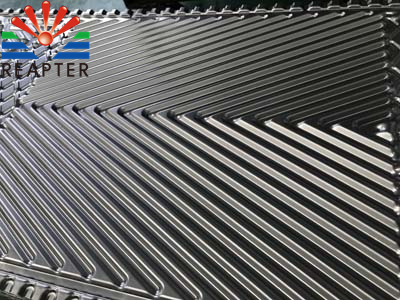How to design the plate angle of a plate heat exchanger
As an efficient and compact heat exchange equipment, plate heat exchangers are widely used in petroleum, chemical, metallurgical and other engineering fields, and play an important role in the national economy and industrial production. Therefore, it is very important to develop and optimize the design of the plate shape and improve the overall performance of the heat exchanger. The corrugation angle is an important design element of the plate exchange. We found that as the plate angle of the plate heat exchanger decreases, the heat exchange performance of the plate heat exchanger is reduced to a certain extent, and the flow resistance is also reduced correspondingly, but the overall performance is correspondingly increased. . In actual work, this conclusion can guide the selection and design of heat exchangers.

Determine the plate angle of the plate heat exchanger mainly based on the following points:
1. The type of medium. The type of medium here is mainly based on the special medium. For example, the mortar used in the photovoltaic industry has a large viscosity and a slow flow rate. Therefore, when selecting a design, we will give priority to a small angle so that the flow rate can be increased.
2. The flow rate, such as the steam-water heat exchanger, the steam flow rate is too large, then our first consideration is to prefer a small angle, because the steam flow rate itself is fast, plus the current large flow rate, considering that the heat of the steam can be fully absorbed Use, a small angle is the first choice
3. Heat exchange area. Some heat exchangers need to be replaced by the whole machine due to their age. However, without knowing any parameters, the heat exchange area can also be provided. Calculate the approximate number of channels based on the heat exchange area, and calculate whether the existing channels can be satisfied based on the average flow rate of the medium in the plate heat exchanger, so as to determine the plate angle of the plate heat exchanger.
Related information
- Professional people do professional things, import quality plate heat exchangers to professional manufacturers
- What are the construction and installation points of plate heat exchanger
- Coal Chemical Industry - Application Case Study of Plate and Shell Heat Exchanger
- Custom made by the manufacturer! Hastelloy C276 plate and shell heat exchanger
- Various uses of plate design for plate and shell heat exchangers
- Plate heat exchangers for pharmaceuticals are being used by peers with large pharmaceutical sales
Relevant article
- Heat station supporting plate heat exchanger installation is a technical work, these points should be noted
- Sulfuric acid and other corrosive media for industrial plate heat exchanger requirements are what
- Simple and effective chemical cleaning method of coal chemical plate heat exchanger, can effectively improve efficiency
- A high-quality petrochemical plate heat exchanger in the production of what to consider
- These causes of chemical plate heat exchanger gasket aging you may not know
- Chemical plant plate heat exchanger, sulfuric acid cooling needs attention
- High-end plate heat exchanger customization, specifically for your special working conditions
- The working principle of gasket type industrial plate heat exchanger and the scenarios of its use are worth knowing in depth
- Still worrying about the wholesale price of industrial plate heat exchangers? An article to make you no longer tangled
- The original lubricant in the chemical plate heat exchanger plays so many roles!
Latest information
- Heat station supporting plate heat exchanger installation is a technical work, these points should be noted
- Sulfuric acid and other corrosive media for industrial plate heat exchanger requirements are what
- Simple and effective chemical cleaning method of coal chemical plate heat exchanger, can effectively improve efficiency
- A high-quality petrochemical plate heat exchanger in the production of what to consider
- These causes of chemical plate heat exchanger gasket aging you may not know
- Chemical plant plate heat exchanger, sulfuric acid cooling needs attention
- High-end plate heat exchanger customization, specifically for your special working conditions
- The working principle of gasket type industrial plate heat exchanger and the scenarios of its use are worth knowing in depth
- Still worrying about the wholesale price of industrial plate heat exchangers? An article to make you no longer tangled
- The original lubricant in the chemical plate heat exchanger plays so many roles!








